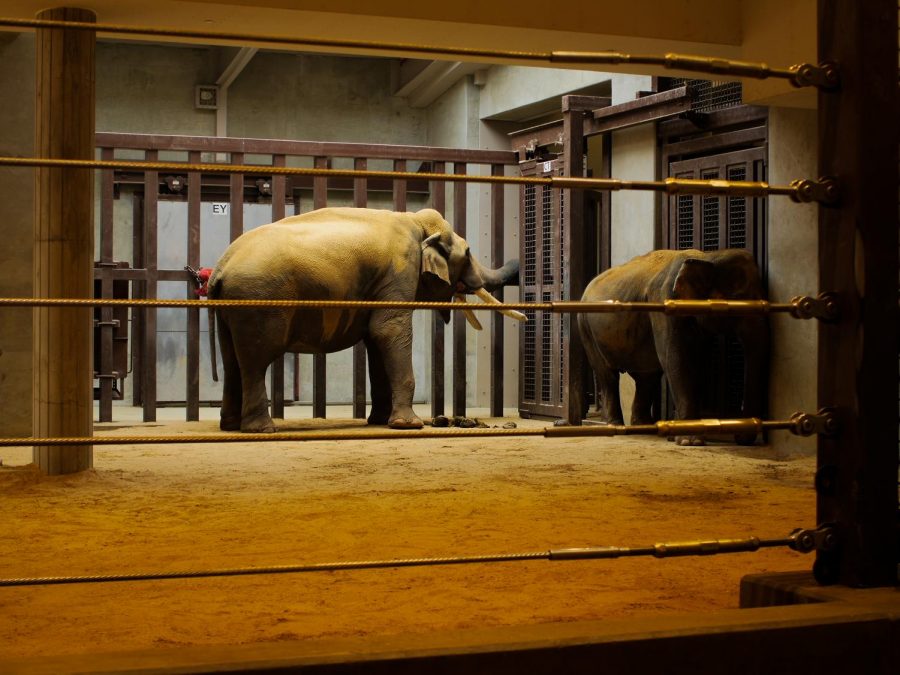Petting Zoos support wellness, education
Every year during finals week, the Wellness Center cooperates with Canine Companions for Independence to set up a schoolwide petting zoo in the amphitheater. Students have the opportunity to connect with the animals, to develop a connection and distract themselves, even for just a few minutes, from their busy lives. This year, Oracle staff went to one of the nation’s most recognizable zoos, the Smithsonian National Zoological Park, to look at the positive benefits of such programs.
Animal Keeper Nikki Maticic had therapy dogs at her high school and is a huge supporter of the practice. “I think [therapy animals] are great, I mean, these guys just kind of have such a way of, even when you can’t touch them, being around them is just such a fascination and you’re just in awe around them,” she said. “It’s amazing to be able to see their personalities and kind of work with them and watch them grow up, and get the opportunity to connect with them–it’s wonderful.”
Kofa Hine, who helps to keep the zoo clean, believes that working with animals has helped him improve his own interactions with others. “When you approach an animal and look at where it is and where it’s come from, you learn something from it,” he said. “You learn something from the birds, from the gorillas, and you learn about the history of the zoo, how long the zoo has been here, and a lot of where people come from. The zoo is a learning ground for me because whenever I come here I learn one or two things before I leave.”
Petting zoos can also help spark career interests for students. “I think with kids it helps to foster that first love of animals and it can get them kind of interested in being passionate with that first love,” Maticic said. “Then it can inspire them to work with other animals.”
Maticic currently works at the Kids’ Farm, the petting zoo element of the park. “I particularly love these guys, [the cows], because they’ve got a lot of personalities and working with them every day is different–same with the cats and bears too–but these guys have a way of kind of growing on your heart, a personality,” she said. “You can interact with them, you can go in and touch them, and those are the only animals you can really do that with so that makes them really special.”
Cedric, who wouldn’t provide a last name for confidentiality reasons, has personally felt the benefits of interacting with the animals. “Here, the animals make me happy, especially the lions, and they motivate me to come to work every day.“
Ranisha Harris, who works in the security of the Kids’ Farm, echoed that sentiment. “I love animals, anywhere I can work with them I will,” she said. “They provide this sort of environment to bring a smile to you every day.”
Beyond providing happiness, petting zoos can also help kids learn about connecting with animals while respecting their boundaries. “I also like that our area of the farm is a petting zoo where we ensure animals always have a choice,” Maticic said. “I think that’s a really important concept for people to learn, not just kids but also adults, that the animals here have the choice to come up and interact with people, they have the choice to want to be pet, so it kind of gives people the idea that you have to be patient with them.” Throughout the zoo, there are signs about ensuring not to feed the animals, and there are mesh boundaries and places the animals can retreat if they don’t want to be pet.
Although students can sometimes be aggressive and overstep those boundaries, Maticic still encourages people to continue participating in petting zoos. “For the one time that you have someone who is negatively interacting with the animals, there are so many other positive interactions with them where they’re coming over and petting the animals and you see someone’s face just light up,” Maticic said. “Those moments I really live for, watching their faces light up, and I’m out here grinning like crazy with them. It’s nice for them to make that connection.”
Your donation will support the student journalists of Henry M. Gunn High School. Your contribution will allow us to purchase equipment and cover our annual website hosting costs.

Nikki Suzani is a Managing Editor for the Oracle, helping to lead the staff and make edits on layouts. In her free time, she enjoys writing for the Los...





Marie Claire • Sep 26, 2022 at 11:09 pm
I’m glad to hear good stories about these children taking care of animals; I just thought that it is an excellent practice to teach young children to sympathize with and love the animals around them. I like to visit a petting zoo soon with my children. I want them to grow up with a close connection to the animals so that they will learn to care for them and protect them when they grow up. A friend of mine mentioned that there is a petting zoo here in Youngstown, OH, and I make sure that I will visit this place sooner if I have time to finally show my children different kinds of animals in the zoo. https://www.ltzoo.com/